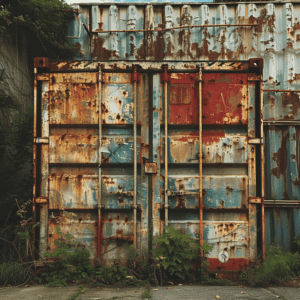Did you know the lifespan of a shipping container isn’t solely determined by its age?
While it’s true that containers have a lifespan of approximately 25 years in maritime service, many factors can significantly shorten or extend this period.
Factors such as location, damage, and how well it’s been maintained can make a world of difference.
So next time you’re looking at a shipping container, ask yourself: what’s its story?
You might be surprised at what you discover.
The Factors That Influence the Lifespan of Shipping Containers
While you may think that all shipping containers are created equal, various factors actually play a significant role in determining their lifespan. You might be surprised to learn that the lifespan of a shipping container isn’t simply measured in years. Instead, it’s determined by a complex interplay of factors that you’ve probably never even considered.
One crucial factor is the type of material used to construct the shipping container. Shipping containers are typically made from steel or aluminum. Steel containers are robust, durable, and can last up to 25 years if they’re properly maintained. Aluminum containers, on the other hand, are lighter and more susceptible to wear and tear, which might shorten their lifespan.
Another key factor is the frequency of use. Just like your car, the more you use your shipping container, the shorter its lifespan is likely to be. Heavy, constant usage can lead to more wear and tear, reducing how long the shipping container lasts.
Location
You mightn’t realize it, but the location where you choose to store your shipping container can greatly impact its longevity. The environment in which the container is placed plays a crucial role in determining the lifespan of a shipping container. For instance, if it’s situated near the sea, it’s susceptible to saltwater damage, which can cause corrosion and significantly reduce its years of service.
Similarly, if your shipping container is located in an area with extreme weather conditions, such as heavy snow or high temperatures, it can experience rapid wear and tear. These harsh conditions can lead to the container’s paint peeling off, rust formation, and structural damage over time.
Even the ground on which the container is placed matters. Soft or uneven ground can lead to structural problems, potentially shortening its lifespan. As a rule of thumb, you should aim to place your shipping container on a flat, solid surface and in an area that isn’t prone to severe weather or environmental hazards. By considering these factors, you can ensure that your shipping container lasts as long as possible.

Damage
Regular maintenance and prompt repairs can vastly extend the life of your shipping container, protecting it from severe damage. However, you need to be vigilant about potential damage from factors such as wear and tear, mishandling, or harsh weather conditions. It’s critical to regularly inspect your container for any signs of damage, particularly rust patches, as they can lead to further damage if left untreated.
Container maintenance plays a crucial role in averting damage. Inspecting the container thoroughly and frequently helps you identify any minor damage early on, so you can initiate immediate repairs. Pay close attention to the roof and corners where leaks may occur. Make sure to repair any holes or cracks promptly to prevent water ingress, which can lead to rust and corrosion.
Minimizing Moisture and Rust
Combatting moisture and rust forms a significant part of maintaining the longevity of your shipping container. These elements can significantly decrease your shipping container’s lifespan if not properly managed. Moisture and rust can eat away at the container’s metal, causing structural damage that could render it useless over time.
To prevent this, it’s essential to take steps in minimizing moisture and rust. Ensure proper ventilation in your container to decrease moisture build-up. Using desiccants can also help absorb excess moisture. Regularly inspect your container for signs of rust and address them promptly.
Painting your container with rust-resistant paint is another effective strategy. This creates a barrier that prevents rust from forming. And don’t forget about the roof – it’s a common rust spot that’s often overlooked!

Frequently Asked Questions
How long can you keep a shipping container?
Shipping containers are renowned for their durability and longevity. Typically, a used container can endure 10-12 years of maritime service before being retired. However, their utility extends far beyond their initial purpose; with proper maintenance, a shipping container’s lifespan can exceed 25 years.
This resilience makes them a valuable asset for various applications, including storage, construction, and even as a foundation for homes.
Do shipping containers rust?
Shipping containers are predominantly made from steel, an iron alloy, making them prone to rust over time. Although they are constructed using marine-grade steel with anti-corrosive properties to enhance their durability, the challenging environments and conditions they face, especially during sea transport, can lead to inevitable rusting. Despite this susceptibility, regular maintenance and protective measures can mitigate rust development and extend the containers’ usability.
What is the lifespan of a container ship?
The lifespan of a container ship is influenced by various factors, including maintenance practices, technological updates, and operational requirements. Generally, container ships are constructed to serve for about 20 to 30 years. However, with diligent maintenance and timely refurbishments, some vessels can remain operational beyond this average range, ensuring they continue to navigate the global trade routes efficiently for extended periods.
What are the drawbacks to shipping container homes?
Shipping container homes come with a unique set of drawbacks despite their growing popularity. Some of the main challenges include difficulties in obtaining building permits due to non-standard construction practices and the scarcity of contractors experienced with container home modifications. Additionally, the shape and size of containers can impose limitations on design and space utilization, often necessitating structural reinforcements. Insulation is another critical concern, as standard containers do not provide adequate thermal protection, requiring significant modifications.
The climate in which the container home is located can also impact its suitability and durability. Furthermore, used containers may pose safety concerns due to their previous contents or exposure to harsh conditions, and fitting standard appliances into the unconventional dimensions of a container home can be problematic.
Conclusion
In conclusion, properly maintaining your shipping container’s condition can significantly extend its lifespan. The average shipping container lifespan largely depends on the care and attention it receives. Without a doubt, neglecting its upkeep may lead to rapid deterioration, while a little TLC can make it last decades.
So how long do shipping containers last? Generally, a well-maintained shipping container can last up to 25 years. However, this isn’t a hard and fast rule. With adequate care and maintenance, you could easily extend this lifespan.
Consider this, shipping containers are designed to withstand harsh conditions at sea. They’re robust, resilient, and have a formidable structure. This means, with you playing your part in their upkeep, they can serve you for an incredibly long time.
In the end, remember it’s all about maintenance. Regularly check for rust, keep moisture at bay, and repair any damage promptly. Do this, and your shipping container won’t only meet but could exceed the average shipping container lifespan. After all, a well-cared-for shipping container is a long-lasting one.


